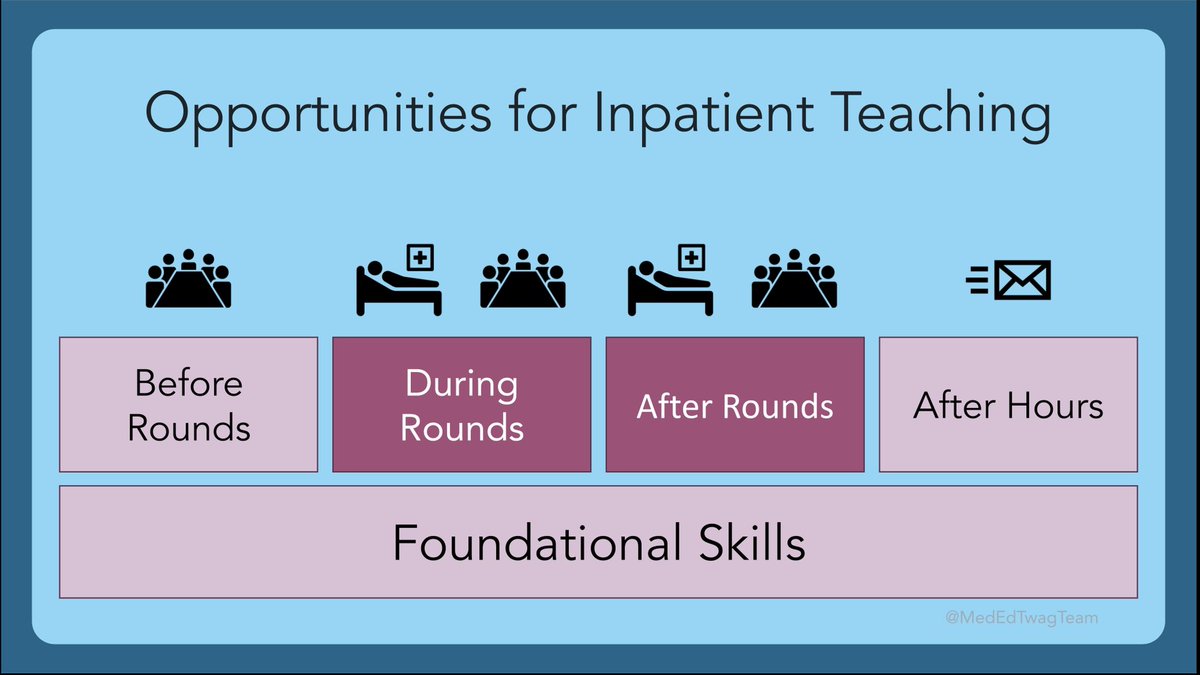1/ “Let’s hear about this patient at the bedside.”
As an educator or learner, does this sentence make you tachycardic??
It’s another #TweetorialTuesday from the @MedEdTwagTeam! #MedTwitter #MedEd #MedStudentTwitter #Tweetorial #FacDev
As an educator or learner, does this sentence make you tachycardic??
It’s another #TweetorialTuesday from the @MedEdTwagTeam! #MedTwitter #MedEd #MedStudentTwitter #Tweetorial #FacDev

2/ We are still covering the foundations of inpatient teaching.
This week, we will focus on general strategies to incorporate bedside teaching effectively into your inpatient teaching tool box!
This week, we will focus on general strategies to incorporate bedside teaching effectively into your inpatient teaching tool box!

3/ First, there are many benefits to teaching @ the bedside for learners, educators, & patients alike.
See articles:
⚡️@DanielRicottaMD TWDFNR @JHospMedicine: tiny.cc/RoundsTWDFNR
⚡️@OlleTenCate Review on Bedside Teaching / tinyurl.com/BedsideReview
See articles:
⚡️@DanielRicottaMD TWDFNR @JHospMedicine: tiny.cc/RoundsTWDFNR
⚡️@OlleTenCate Review on Bedside Teaching / tinyurl.com/BedsideReview

4/ Let’s be real tho…
As an EDUCATOR, how do you feel when you imagine yourself teaching or asking for presentations at the bedside with your inpatient team?
As an EDUCATOR, how do you feel when you imagine yourself teaching or asking for presentations at the bedside with your inpatient team?
5/ And let’s be honest…
#MedStudentTwitter, as a LEARNER, how do you feel when your attending says, “Let’s learn/present at the bedside”?
#MedStudentTwitter, as a LEARNER, how do you feel when your attending says, “Let’s learn/present at the bedside”?
6/ I think most of us believe that we SHOULD be teaching & learning more at the bedside. But there are certainly challenges and perceived barriers to bedside teaching. 

7/ Despite these challenges, I’d like to encourage us that bedside teaching is done in many ways! Please see 👇🏼 for options.
Read on for strategies to overcome common pt, learner, & content-based challenges to bedside teaching that can be utilized in any of these settings.
Read on for strategies to overcome common pt, learner, & content-based challenges to bedside teaching that can be utilized in any of these settings.

8/ Learners often feel bedside teaching takes too much🕐, become disengaged in a large group @ the bedside, or worry a/b seeming uncertain in front of pts.
Please refer to my prior tweetorial for additional details about these strategies:
Please refer to my prior tweetorial for additional details about these strategies:
https://twitter.com/YihanYangMD/status/1234434208673804289?s=20

9/ I’ll note that learner buy-in for bedside teaching (esp bedside rounds) can be challenging if you’re @ an institution where it’s not part of the culture.
I’ve personally learned that as the attending, my team’s culture is what I make it.
If you believe it, stick to it!
I’ve personally learned that as the attending, my team’s culture is what I make it.
If you believe it, stick to it!

10/ For pts, it’s important to maintain privacy & comfort while still engaging them. Use my acronym “PATIENTS”👇🏼
And… unless a pt is @ danger of harming self/others, no one is too “difficult”/ “boring.”
More detailed tips in my tweetorial:
And… unless a pt is @ danger of harming self/others, no one is too “difficult”/ “boring.”
More detailed tips in my tweetorial:
https://twitter.com/YihanYangMD/status/1236964190008619008?s=20

11/ Finally… Yes! It can be intimidating to decide WHAT to teach at the bedside.
Remember to:
⚡️FOCUS. Less=more during bedside teaching
⚡️Identify the relevance
⚡️Check out them resources!
More details on these tips:
Remember to:
⚡️FOCUS. Less=more during bedside teaching
⚡️Identify the relevance
⚡️Check out them resources!
More details on these tips:
https://twitter.com/YihanYangMD/status/1239512665661333504?s=20

12/ The framework👇🏼for bedside teaching is one that I modified from Janicik. It incorporates strategies to overcome learner, pt, & content challenges.
You can consolidate outside room tasks to before/after rounds rather than each pt encounter if you’re rounding @ the bedside.
You can consolidate outside room tasks to before/after rounds rather than each pt encounter if you’re rounding @ the bedside.

13/ Need more bedside teaching pearls?
Stay tuned! Later in the fall the @MedEdTwagTeam will cover tips on how to teach:
🔥history taking
🔥physical exam at the bedside
🔥communicating with interdisciplinary staff & patients
Stay tuned! Later in the fall the @MedEdTwagTeam will cover tips on how to teach:
🔥history taking
🔥physical exam at the bedside
🔥communicating with interdisciplinary staff & patients
14/ For now, I’ll wrap with some additional reading and references for bedside teaching.
Please scan the codes to download a file with relevant articles, and a pocket card cheat sheet ☺
Please scan the codes to download a file with relevant articles, and a pocket card cheat sheet ☺

15/ #MedTwitter, how do you teach at the bedside? Drop us some of your tips!
Also, stay tuned for a VERY SPECIAL @MedEdTwagTeam ANNOUNCEMENT next week!
In the mean time, make sure to follow @GStetsonMD, @JenniferSpicer4, @YihanYangMD so you don’t miss any of our content!
Also, stay tuned for a VERY SPECIAL @MedEdTwagTeam ANNOUNCEMENT next week!
In the mean time, make sure to follow @GStetsonMD, @JenniferSpicer4, @YihanYangMD so you don’t miss any of our content!

• • •
Missing some Tweet in this thread? You can try to
force a refresh






















